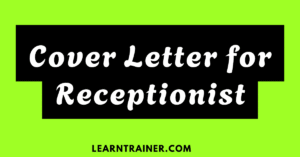Have you ever found yourself in a situation where you’re struggling with the rising cost of fuel and wish there was some way to ease the financial burden?
Whether you’re driving for work, commuting, or simply need a little extra support for fuel expenses, a fuel allowance can be a life-saver. This is where writing a well-crafted fuel allowance request letter comes into play.
Fuel allowances are often provided by employers, organizations, or government bodies to support individuals who use their own vehicles for work-related tasks. However, it’s not always as simple as just asking for it.
A professional and clear request letter is the key to increasing your chances of getting the allowance you need.
In this article, we’ll explore five examples of fuel allowance request letters, break down the essential elements of a successful request, and share common mistakes to avoid.
By the end, you’ll be well-equipped to write your own letter and secure the fuel allowance you deserve.
What is a Fuel Allowance and Why Should You Request It?
A fuel allowance is a monetary contribution towards the cost of fuel used for work-related travel. This can be offered by employers to employees who are required to travel for their job, such as salespeople, delivery drivers, or even remote workers who have to commute to different locations.
The idea behind a fuel allowance is to relieve workers from the financial strain of paying for fuel out of pocket while also encouraging efficiency and productivity.
Depending on the organization or country, fuel allowances may be offered as a fixed amount, a percentage of fuel costs, or reimbursed after submitting receipts.
If you’re regularly traveling for work or your job requires a lot of driving, a fuel allowance could make a significant difference. But how do you go about requesting this allowance?
That’s where the request letter comes in. Below, we’ll walk through five samples that you can use as templates for your own letter.
Sample 1: Simple Fuel Allowance Request for Employees
[Your Name]
[Your Address]
[City, State, ZIP Code]
[Email Address]
[Phone Number]
[Date]
[Manager’s Name]
[Company Name]
[Company Address]
[City, State, ZIP Code]
Dear [Manager’s Name],
I hope this message finds you well. I am writing to formally request a fuel allowance to assist with the costs I incur while traveling for work. As part of my role as [Your Job Title], I frequently need to use my personal vehicle to visit clients, attend meetings, and complete various tasks related to my job responsibilities.
Over the past [duration], I’ve noticed that the cost of fuel has increased, and I find myself struggling to cover these expenses alongside my regular living costs. A fuel allowance would significantly help in covering the additional financial strain and allow me to continue fulfilling my duties efficiently.
I would greatly appreciate it if we could discuss the possibility of a fuel allowance to help offset my commuting costs. I am confident that this support will not only help with my personal expenses but will also enhance my productivity in performing my work tasks.
Thank you for your time and consideration. I look forward to hearing from you soon.
Sincerely,
[Your Name]
Sample 2: Detailed Fuel Allowance Request with Supporting Information
[Your Name]
[Your Address]
[City, State, ZIP Code]
[Email Address]
[Phone Number]
[Date]
[Manager’s Name]
[Company Name]
[Company Address]
[City, State, ZIP Code]
Dear [Manager’s Name],
I am writing to request a fuel allowance to help manage the rising expenses associated with the travel required for my role as [Your Job Title]. As you know, my position requires regular visits to [mention locations or clients], and over the past few months, fuel prices have significantly increased.
Based on my travel records, I have calculated that I am driving approximately [number of miles] per week for business-related activities, which adds up to a significant portion of my personal expenses. For the month of [Month], I spent [X amount] on fuel alone. I have attached the relevant documentation, including mileage logs and fuel receipts, for your review.
A fuel allowance would provide much-needed relief, allowing me to continue fulfilling my job responsibilities without the additional financial strain. I suggest that we consider either a fixed monthly allowance or reimbursement based on mileage.
I would appreciate the opportunity to discuss this matter further and look forward to your response.
Thank you for your time and consideration.
Sincerely,
[Your Name]
Sample 3: Request Letter for Fuel Allowance for Remote Workers
[Your Name]
[Your Address]
[City, State, ZIP Code]
[Email Address]
[Phone Number]
[Date]
[Manager’s Name]
[Company Name]
[Company Address]
[City, State, ZIP Code]
Dear [Manager’s Name],
I hope you are doing well. I am writing to discuss the possibility of receiving a fuel allowance for the travel I do as part of my remote working duties. As a [Job Title], I am required to commute to various locations, including [specific locations], for meetings, site inspections, and training sessions. The increased frequency of these work-related travels, coupled with the rising fuel costs, has made it increasingly difficult to manage the expenses on my own.
Over the last [X] months, my fuel expenses have increased by [percentage]. This is becoming a significant burden, and I believe a fuel allowance would help alleviate some of the financial strain. I am open to discussing any arrangement that works best for the company, whether that be a fixed monthly allowance or reimbursement for mileage.
Thank you for considering my request. I look forward to discussing this further.
Sincerely,
[Your Name]
Sample 4: Formal Request for Fuel Allowance with Company Policy Reference
[Your Name]
[Your Address]
[City, State, ZIP Code]
[Email Address]
[Phone Number]
[Date]
[HR Manager’s Name]
[Company Name]
[Company Address]
[City, State, ZIP Code]
Dear [HR Manager’s Name],
I am writing to formally request a fuel allowance to assist with the increased travel expenses I have incurred as part of my duties in [Department]. As per the company’s travel policy, employees who use their personal vehicles for business-related tasks are eligible for reimbursement or an allowance for fuel costs. Given the nature of my role as [Job Title], I frequently travel to [mention destinations], which requires the use of my own vehicle.
I have reviewed the company’s policy and believe I qualify for the fuel allowance outlined. I would be grateful for your assistance in processing this request, and I am more than happy to provide any additional documentation or details required. I look forward to your response and hope to finalize this matter soon.
Thank you for your attention to this request.
Sincerely,
[Your Name]
Sample 5: Fuel Allowance Request for Freelancers
[Your Name]
[Your Address]
[City, State, ZIP Code]
[Email Address]
[Phone Number]
[Date]
[Client’s Name]
[Client’s Company Name]
[Company Address]
[City, State, ZIP Code]
Dear [Client’s Name],
I hope this message finds you well. As a freelancer working with [Client’s Company Name], I have been involved in multiple projects that require frequent travel to meet with clients, attend site visits, and perform other related tasks. Due to the rising cost of fuel, I am requesting a fuel allowance to help cover these increased expenses.
I believe a reasonable allowance for fuel costs would allow me to continue working efficiently without the additional financial burden. I have attached a breakdown of my travel for the last [X] months, which includes mileage and fuel expenses.
Please let me know if you would be open to discussing a fuel allowance or reimbursement for my travel costs. I look forward to your response and am happy to discuss this further.
Sincerely,
[Your Name]
Common Mistakes to Avoid When Writing a Fuel Allowance Request
- Lack of Specifics: Failing to include specific figures, dates, or receipts can weaken your request. Always provide clear, quantifiable details about your travel and expenses.
- Being Too Informal: While a friendly tone is important, ensure your request remains professional. Avoid overly casual language.
- Not Following Up: After sending the letter, don’t forget to follow up. This shows your seriousness and commitment to the matter.
- Ignoring Company Policy: Always check if your company has a fuel allowance policy. Not following the guidelines can result in your request being rejected.
Conclusion: Next Steps
Requesting a fuel allowance doesn’t have to be a daunting task. By following the tips and examples provided in this article, you can write a clear, effective letter that presents your case in the best possible light. Make sure to include all relevant information, stay professional, and follow up appropriately.
If you’re ready to submit your fuel allowance request, use the examples above as a template and customize them to suit your specific situation. Good luck, and don’t forget to share your experiences or ask questions in the comments below!
FAQs About Fuel Allowance Requests
- What should I include in a fuel allowance request letter?
- Always include your reason for the request, relevant details about your travel, and a clear request for assistance.
- How do I calculate my fuel expenses for the request?
- Track your mileage and calculate the average cost of fuel over a period of time to provide an accurate estimate.
- Can I request a fuel allowance if I am a freelancer?
- Yes! Freelancers can request fuel allowances from clients, especially if their work involves regular travel.
- What’s the best way to follow up after sending my request?
- Politely follow up via email or in person after a week or two to check on the status of your request.
- What if my company doesn’t have a fuel allowance policy?
- If there’s no policy, present your case with clear evidence of your expenses and the impact on your work, and request a discussion about the possibility of starting one.


